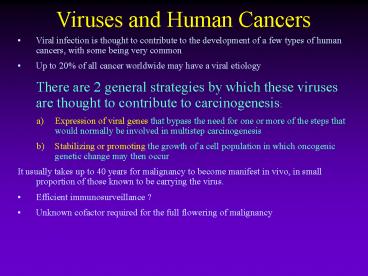Viruses and Human Cancers - PowerPoint PPT Presentation
1 / 9
Title:
Viruses and Human Cancers
Description:
Up to 20% of all cancer worldwide may have a viral etiology ... 5. Other mechanisms of viral transformation and oncogenesis. Mechanism of Viral Transformation ... – PowerPoint PPT presentation
Number of Views:104
Avg rating:3.0/5.0
Title: Viruses and Human Cancers
1
Viruses and Human Cancers
- Viral infection is thought to contribute to the
development of a few types of human cancers, with
some being very common - Up to 20 of all cancer worldwide may have a
viral etiology - There are 2 general strategies by which these
viruses are thought to contribute to
carcinogenesis - Expression of viral genes that bypass the need
for one or more of the steps that would normally
be involved in multistep carcinogenesis - Stabilizing or promoting the growth of a cell
population in which oncogenic genetic change may
then occur - It usually takes up to 40 years for malignancy to
become manifest in vivo, in small proportion of
those known to be carrying the virus. - Efficient immunosurveillance ?
- Unknown cofactor required for the full flowering
of malignancy
2
Convicting a Human Tumor Virus Guilt by
association ?
- A strong epidemiological association of the virus
with the disease must be made - Detection of the viral agent or its products in
the diseased tissue - Experimental models proving the carcinogenic or
transforming potential of the virus or viral
genes - Cell transformation in vitro
- Production of tumors in susceptible animals
- Tumor production in transgenic mice
3
Oncogenic Viruses and Cancer
4
Viruses Established As Etiologic Agents and Risk
Factors for Human Cancers
5
Genome Map of Human Tumor Viruses
6
Mechanism of Viral Transformation
1. Viral transformation by activating of cellular
signal transduction pathways. 2. Alteration of
the expression or activity of cellular signal
transduction proteins 3. Viral transformation via
cell cycle control pathway 4. Viral
transformation via modulation of apoptosis 5.
Other mechanisms of viral transformation and
oncogenesis
7
pRb and p53 genes Are Major Targets of Viral
Oncoproteins
- The various roles played by tumor suppressor
genes in tumorigenesis are still being defined.
Potential ways in which these genes can inhibit
the development of cancer include - inhibiting cell proliferation
- inducing differentiation
- inducing cell death
- stimulating DNA repair.
- p53 plays key role in inhibiting tumor
development through - checkpoint control of the cell cycle
- inducing of apoptosis
- stimulating of DNA repair mechanisms.
- pRb and p53 related proteins are regulators of
the cell cycle. - Viral oncoproteins form complexes with pRb and
p53. The physical interactions inactivate their
function.
8
Inactivation of P53 by Viral Oncoproteins
Degradation
Sequestered p53
Binding
9
Abrogation of the Function of the pRb Protein

